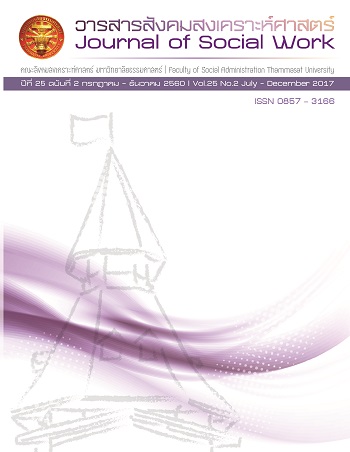Study on the Conditions Achieving the Development of the Child Protection System to Cover and Access the Marginalized Children on the Thai-Myanmar Border
Keywords:
Child protection system, Sub-district (Tambon), Marginalized Children on the Thai-Myanmar BorderAbstract
This study aimed to investigate the conditions achieving the development of the child protection system to cover and access the marginalized children on the Thai-Myanmar border, using the methodology of grounded theory as the study guidance. According to the study findings, the first condition leading to the development of the child protection system to cover and access the marginalized children was the role of project coordinators in each area. Regardless of working unit, the coordinators from all organizations should have the underlying characteristics as follows: They should enhance the trust of the target group and indicate their good intention on the child protection. When the permission was approved by the highest superior in the locality, the participants would realize the importance of the activity as this was regarded as the official and hierarchical cooperation. For the second condition, the lecturers should have the knowledge and experience on the child protection. They should understand the lifestyle of the participants and can work as the mentor for the organization. With these qualifications, the child protection system will be continuous. As the lecturers can provide consultation and work under challenging conditions, the sub-district child protection could be extended to cover more non-Thai or abandoned children. The third condition was involved with the vision of community leaders. If the community leaders, especially the chief executive of the Sub-district Administrative Organization (SAO), have the vision to achieve and manage a peaceful community and pay respect to all humans, the child protection will be equally provided to both Thai and non-Thai children. And finally, the fourth condition was the mutual coordination with the child protection committee in sub-district and provincial levels that should be promoted to enhance the child protection policies and networks more efficiently.
References
คณะกรรมการสิทธิมนุษยชนแห่งชาติ. (2549). พระราชบัญญัติคุ้มครองเด็ก พ.ศ. 2546. กรุงเทพฯ : สำนักงานคณะกรรมการสิทธิมนุษยชนแห่งชาติ.
ดวงพร เพชรคง. (2558). ปัญหาและอุปสรรคจากการบังคับใช้พระราชบัญญัติคุ้มครองเด็ก พ.ศ. 2546. กรุงเทพฯ: สำนักงานเลขาธิการสภาผู้แทนราษฎร.
นภาภรณ์ หะวานนท์ และคณะ. (2543). รายงานการวิจัยเรื่อง การศึกษาเงื่อนไขความสำเร็จในการดำเนินงานของคณะกรรมการโรงเรียน.ภายใต้การสนับสนุนของสำนักงานคณะกรรมการการศึกษาแห่งชาติ สำนักนายกรัฐมนตรี.
มูลนิธิเพื่อยุติการแสวงหาประโยชน์ทางเพศจากเด็ก. (2558). คู่มือสำหรับเด็กเกี่ยวกับนโยบายคุ้มครองเด็ก.เชียงราย.เอกสารอัดสำเนา.
วิศิษฐ์ ผลดก. (2554). การพัฒนาทีมสหวิชาชีพเพื่อคุ้มครองเด็กที่ถูกทารุณกรรมจังหวัดอุบลราชธานี. หลักสูตรปริญญารัฐประศาสนศาสตรมหาบัณฑิต สาขาวิชารัฐประศาสนศาสตร์ คณะรัฐศาสตร์ มหาวิทยาลัยอุบลราชธานี.
สำนักงานเขตประเวศ. (2558). ทะเบียนประเวศ.สืบค้นเมื่อวันที่ 25 พฤษภาคม 2558 สืบค้นจากhttp://tabianprawet.blogspot.com/2012/04/blog-post.html .
องค์การยูนิเซฟ. (2554). การวิเคราะห์สถานการณ์เด็กและสตรี พ.ศ. 2554.สืบค้นเมื่อวันที่ 22 เมษายน 2558. สืบค้นจากhttp://www.unicef.org/thailand/tha/1046
องค์กรเอ็คแพท อินเตอร์เนชั่นแนล. (2556). รายงานการศึกษา ข้อเสนอการพัฒนาระบบคุ้มครองเด็กในพื้นที่เมืองพัทยาจังหวัดชลบุรี. เสนอต่อ สำนักงานส่งเสริมสวัสดิภาพและพิทักษ์เด็ก เยาวชน ผู้ด้อยโอกาสและผู้สูงอายุ.
Green, M.Y. (2002). Minorities as majority: Disproportionality in child welfare and juvenile.Children’s Voice, November/December. Retrived 20 April 2015 from http://www.cwla.org/articles/cv0211minorities.htm
Naruemon et al. (2009). Participative Model of Child Protection in Northern Thailand. Thai J Nurs Res, 13, 216-225.
Roque and Erin. (2010). Building community within the community: Government-community partnerships in the District of Columbia’s child welfare system. Social Work Now. April, 8-13.
Downloads
Published
How to Cite
Issue
Section
License
The manuscripts published in the Social Work Journal is the copyright of the Social Work Journal, Thammasat University
Any article or opinion appeared in the Social Work Journal will solely be under the responsibility of the author The Faculty of Social Administration, Thammasat University and the editors do not need to reach in agreement or hold any responsibility.



